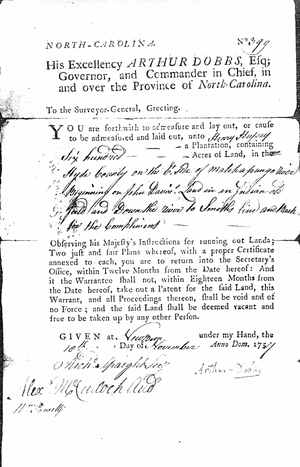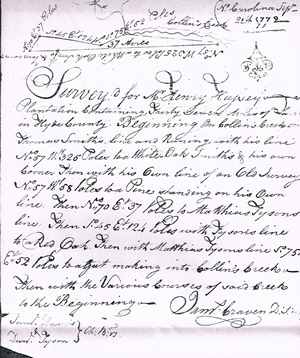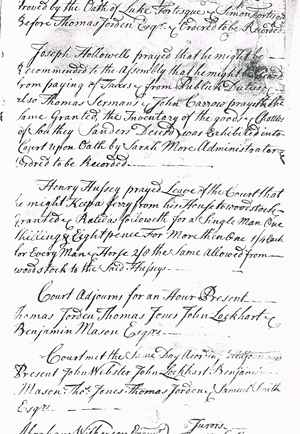Henry Hussey
The Oldest Known Hussey
Henry Hussey is a mystery that we have been trying to solve for many years. Documents place
him in the English colony known as the Province of North Carolina in 1753. At that time he
was already grown, was a cordwainer and owned land. We know he was a cordwainer or shoemaker
from several legal documents that refer to him as Henry Hussey, Cordwainer
or in
another case Henry Hussey Shoemaker
. It is logical that he was older because to
become a cordwainer required an apprenticeship of several years. Beyond these deductions, we
know nothing of Henry's early life, where he came from or the source of his money.
There is no doubt that Henry was a pioneer in a sparsely seattled and dangerous place at the southern end of the outer banks of North Carolina. His home was located on the edge of "The Great Alligator Dismal Swamp". The infamous pirate Blackbeard set up a base just across Pamlico Sound from Henry on Occacock Island. Blackbeard's Occacock Island base was attacked by forces of the british navy and Blackbeard was killed.
Land Holdings
Records show that Henry had a substantial tract of land that he expanded during his lifetime. Subsequently his son Thomas lived on this land for most of his life.
Survey methods and the descriptions used to register deeds in the 1700's were frequently
relative to landmarks that are no longer identifiable. Henry's surveys included terms such
as beg [begin] chestnut oak being boundary of my fathers survey
or along Cypress
Swamp S to deep branch
. However, three items allow us to locate the his holdings
pretty accurately.
- All his surveys were located on on the east side of the Machapongo river that is now known as the Pungo river.
- Two surveys make reference to Slade Creek that is still identifiable.
- Court records show that Henry's house was located across from Woodstock, which was then the county seat. Woodstock was abandoned in the 1820's. However its sunken remains can be seen from Woodstock Point that appears on modern maps.
Here are a few of Henry's land transactions.
- March 17, 1753 - Henry Hussey to Richard Wilkinson, 120 acres, 10 Pounds 13 Shillings
- September 6, 1756 - William Slade to Henry Hussey, 156 acres, 15 Pounds
- August 23, 1757 - Henry Hussey to Thomas Easter, 156 acres, 18 Pounds
- August 29, 1760 - Henry Hussey to William Caron, 300 acres, 50 Pounds
Land Patents
Henry applied for and was granted two land patents, often called land grants.
- November 18, 1757 - 600 acres
- January 30, 1773 - 37 acres
The most straight forward way to obtain a parcel of vacant land was to purchase it from the government This was called a purchase grant but still required the purchaser to follow an expensive process.
The second way was by importing individuals into the colony which was known as a headright grant. This system was created because of a dire shortage of workers in the colony.Typically this involved a well to do patron paying the passage of people too poor to pay their own way. In exchange the individual was obligated, that is to say indentured, to the patron for a period of four to seven years to work as the patron saw fit. The cost of passage was approximately six pounds per person or $215 in todays dollars. Additionally, involuntary headrights came into being as courts in England sent convicts to the colonies, often for minor offenses. It is estimated that almost half of the European immigrants to the 13 colonies before 1774 were indentured.
The headright system was subject to many abuses. Headright patrons often colluded with ship captains to count individuals who died on the journey and to otherwise inflate the numbers. Government officials were frequently corrupt easily bribed. Therefore, records show a large discrepancy between the number of headrights issued and the number of new individuals in the colonies.
The life of indentured individuals was harsh. Physical abuse, exposure and poor food were a constant. Women faired worse than men. The indenture contract stipulated some end of term bonus. Most included land and a small amount of money. The wrinkle was that the land that was available was usually on the frontier where the French and Indian war was being fought. The reality was that only about 40% of the indentured people lived to complete their indenture term.
Regardless of whether it was a purchase grant or a headright grant, obtaining the land patent required navigating a bureaucracy and paying a series of fees. The fees were approximately 25 Pounds in total, which was a significant amount of sterling silver.
There is no record of how Henry worked his land. With no machinery, collecting pine gum and farming on land as extensive as Henry's required a substantial number of laborers. While it is unknown if Henry used indentured laborers, he did own slaves. Records of the exact number of slaves and what work they performed were not kept in that era.
Hints at Henry's business
Naval Stores were the leading industry of the region during this period. Several records indicate that this was a major business for Henry. He collected gum from the abundant pine trees on his land. The records refer to turpentine and it is unclear if that is a common name for pine rosin or if Henry distilled the rosin into turpentine.
In September 1754, Henry recorded his cattle mark with the Hyde County Court. A Crap and
Slit in the left ear, a Split in the right ear
.
In June of 1765, he petitioned the Hyde County Court for permission to operate a ferry service between his house on the eastern bank of the Machapounga River (Pungo River) and Woodstock on the western bank of the river. Woodstock was the county seat for Hyde County from 1738 to 1778. He charged:
- 1 shilling and 8 pence for a single man
- 1 shilling and 4 pence for more than one man
- 2 shilling and 8 pence for every man and horse



